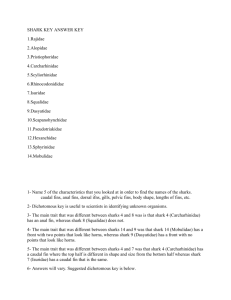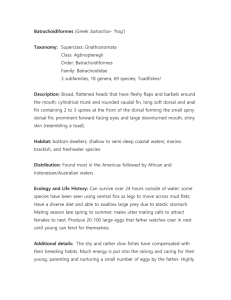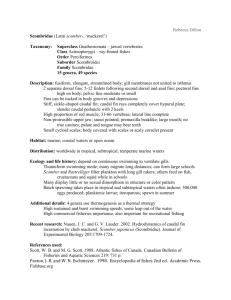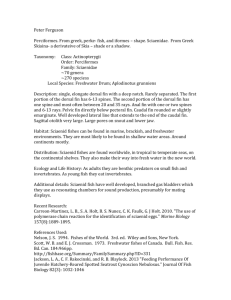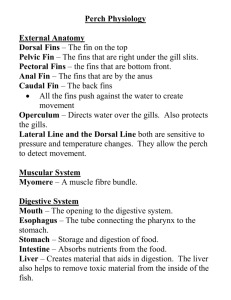Michigan Fishes II Powerpoint
advertisement
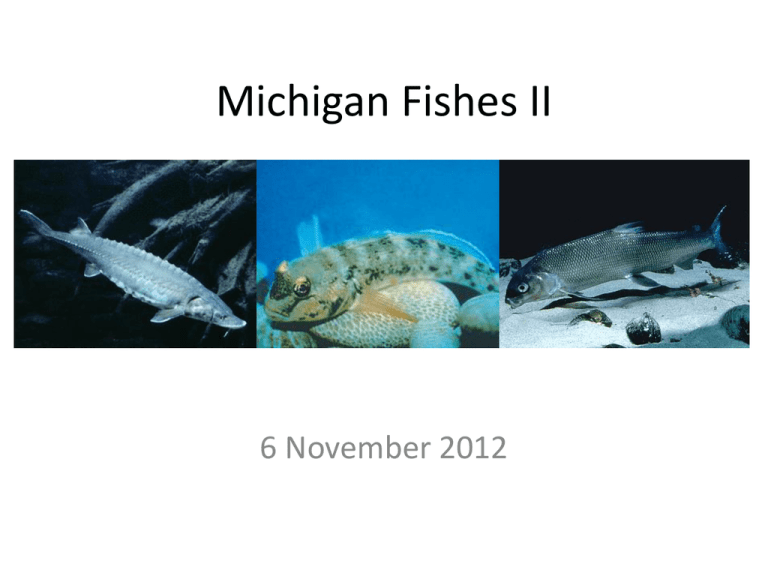
Michigan Fishes II 6 November 2012 Non-native species 26 total in Michigan! • Petromyzontidae: Petromyzon marinus – sea lamprey • Anguillidae: Anguilla rostrata – American eel • Clupeidae: Alosa pseudoharengus - alewife • Osmeridae: Osmerus mordax – rainbow smelt • Gobiidae: Neogobius melanostomus – round goby • • • • Cyprinidae: Cyprinus carpio – common carp Salmonidae: Oncorhynchus mykiss – rainbow trout Salmonidae: Salmo trutta – brown trout Centrarchidae: Lepomis microlophus – redear sunfish Threatened species ~35 threatened, endangered, or extirpated in Michigan • Acipenseridae: Acipenser fulvescens – lake sturgeon (T) • Hiodontidae: Hiodon tergisus – mooneye (T) • Lepisosteus oculatus – spotted gar (SC) • Noturus stigmosus – northern madtom (EN) • Noturus miurus – brindled madtom (SC) Source: http://web4.msue.msu.edu/mnfi/data/specialanimals.cfm Commercially important fishes • Esocidae: Esox masquinongy – muskellunge • Salmonidae: Coregonus clupeaformis – lake whitefish • Percidae: Stizostedion vitreum – walleye • Centrarchidae – Ambloplites rupestris – rock bass – Lepomis macrochirus – bluegill – Lepomis gibbosus – pumpkinseed – Micropterus spp. – smallmouth and largemouth bass Misc. • Lepisosteidae: Lepisosteus osseus – longnose gar Petromyzontidae Lampreys: family characteristics • Body eel-like • Mouth is a sucking disc • No jaws, no paired fins, no scales • Single median nostril • Seven external gill openings on each side Petromyzon marinus – sea lamprey • • • • • • Separate dorsal fins Teeth in radiating rows Adults parasitic – disc as wide as body Big – commonly 30-60 cm or more Native to Finger Lakes of New York, introduced to Great Lakes in mid-1800s, decimated local fish populations in 1930s and 40s Control efforts, including electric current, chemical lampricides, and barriers, vary in success Anguillidae Freshwater eels: family characteristics • Body anguilliform • Pectoral fins present, pelvic fins absent • Terminal mouth, jaws well toothed • Small, embedded, linear scales • Median fins (dorsal, caudal, anal) continuous Anguilla rostrata – American eel • • • • • • Sharp pointed head, jaws present Only eel species in Michigan Catadromous Leptocephalus larval stage Introduced to Great Lakes in 1800s – stocked in rivers in Illinois, thrown overboard from ships carrying them as rations Impacts in Michigan unknown, but in Texas and S. Carolina have brought Asian nematode Clupeidae Shads and herrings: family characteristics • Compressed body • Thin cycloid scales • Head naked • Midline of belly with spiny scutes • No lateral line • Gill rakers numerous and long Alosa pseudoharengus – alewife • • • • • • • Body more elongate and streamlined than Dorosoma cepedianum Upper margin of mandible forms strong shoulder Invaded Lake Ontario in late 1800s, successful due to overfishing of large Salmonid predators Distributed to Great Lakes in mid-1900s Impact: restructures food web May be responsible for decline of native salmonids (e.g., lake herring, arctic grayling) Periodic large-scale die-offs in 1960s annoying and a health hazard! Osmeridae Smelts: family characteristics • Body slender and compressed • Single soft-rayed dorsal fin • Adipose fin • Head naked, body scales cycloid, mod. size • Large mouth with strong teeth • Tongue with fangs! Osmerus mordax – rainbow smelt • • • • • • • Only Osmerid in Michigan Long slender body Closely resembles Salmonids (both families in Order Salmoniformes) Like many salmon species, spawn in streams (in this species, in early spring) Rainbow smelt eggs were stocked in 1912 in Crystal Lake which drains into Lake Michigan Now commercial fishery May have contributed to loss of blue pike from Great Lakes, compete with juvenile lake trout Gobiidae Gobies: family characteristics • Large head, sharp teeth, usually terminal mouth • Two dorsal fins • Flexible spine at beginning of anal fin and 2nd dorsal fin • Pelvic fins fused to form disc-like cup • Family extremely speciose Neogobius melanostomus– round goby • • • • • No opercular spines – distinguish from? Black spot at posterior of first dorsal fin Native to Eurasia Compete with native species for food Feed on eggs and fry of sculpin and darters Non-native review species • Cyprinidae: Cyprinus carpio – common carp – Native to Eurasia – Records in all states but Alaska – Deteriorates habitat by eating vegetation, increasing turbidity • Salmonidae: Salmo trutta (brown trout) and Oncorhynchus mykiss (rainbow trout) – Both stocked for fisheries • Centrarchidae: Lepomis microlophus – redear sunfish – Native to Southeast/lower Midwest – Intentionally stocked for sportfishing – Molluscivorous, so may compete with L. gibbosus Acipenseridae Sturgeons: family characteristics • Body with five rows of bony plates • Caudal fin heterocercal • Mouth ventral and protrusible • Conical snout with two pairs of elongate barbels • Partly cartilaginous skeleton Acipenser fulvescens – lake sturgeon • • • Juveniles with long, pointed nose and large bony plates Barbels (usually 4) surround mouth Threatened due to: – Overharvesting – Pollution – Closing of migratory channels Hiodontidae Mooneyes: family characteristics • Body compressed and herring-like • Midline of belly keeled but without spiny scutes • Large eye, no adipose fin, single short dorsal fin Hiodon tergisus – mooneye • • • • • Silvery body Lateral line distinct Moth strongly toothed, including toothed plate on tongue One of only two Osteoglossomorph spp in N America Impact factors: – Isolated populations – Intolerant to silt and turbidity – Agriculture and industrialization Review threatened species • Ictaluridae: Noturus miurus & N. stigmosus – Intolerant to pollutants – Sensitive to increased turbidity, siltation, and stream flow alterations – Are in decline all across range – N. miurus competes for spawning ground and cover with round goby • Lepisosteidae: Lepisosteus oculatus – Requires clear vegetated water these habitats in decline across range – Sensitive to siltation, dredging, and harbor improvements Esocidae Pikes: family characteristics • Body elongate, terete • Single dorsal, opposed to anal, far back on body • Snout duck-like with canine teeth • Caudal fin forked Esox musquinongy – muskellunge • Scales on only upper half of cheek and opercle • Dorsal, caudal, and anal fins with dusky spots • Dark bars on light background (not always visible in large specimens) • “Legendary for its size” – record 65” and 70 lb Salmonidae Trouts: family characteristics • • • Body terete to moderately compressed Single soft-rayed dorsal fin, adipose fin present Cycloid scales on body, head naked Coregonus clupeaformis – lake whitefish • • • • • Mouth subterminal Snout rounded Axillary scale present Two flaps between nostrils Most important commercial fish in lakes Ontario and Huron – • • More than $5mill in catches from these two lakes in 1 yr Critical component in Lake Michigan commercial fishery Popular sport fish in all of the Great Lakes Percidae Perches: family characteristics • Body usually elongate • Two dorsal fins that may be contiguous or separate • Anal fin with 1 or 2 spines • Lateral line usually complete Stizostedion vitreum - walleye • • • • Dusky blotch on webbing between last 3 dorsal spines (1st dorsal) Tip of lower lobe of caudal fin and anal fin white Grow to 25” and 5 lb In peak years, make up half the value of Lake Erie fishery Lepisosteidae Gars: family characteristics • Body elongate with ganoid (rhombic) scales • Snout and jaws extended into strong flattened beak with conical teeth • Caudal fin abbreviate heterocercal Lepisosteus osseus – longnose gar • • • • Snout beak-like, long and narrow Head not spotted Black streak across body Grows to 72” in length

